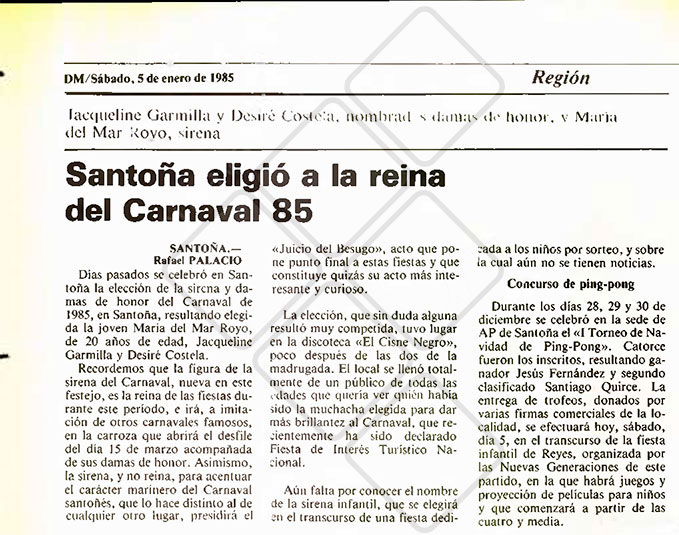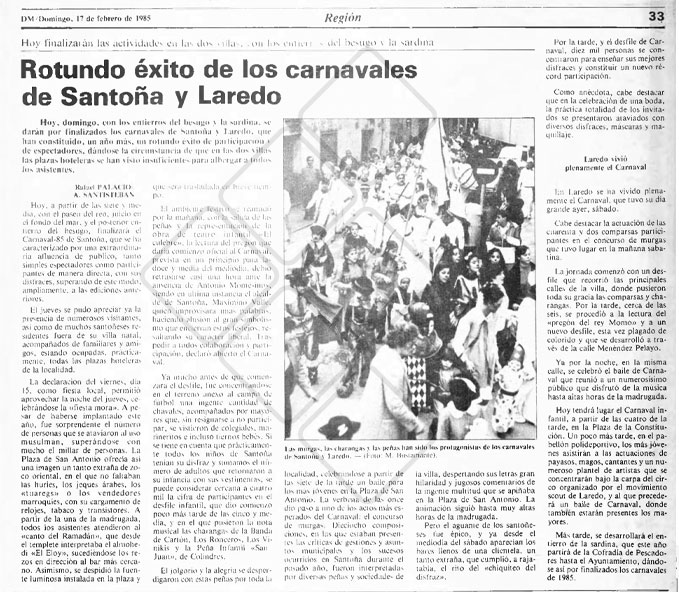...1985 only reaffirmed the remarkable growth of the Santoña Carnival. If the previous year had already ended with extraordinary figures and an overwhelming festive atmosphere, this new season began with news that provided institutional recognition to what the people of Santoña had long known: the official declaration of the Santoña Carnival as a Festival of Tourist Interest....
Carnival history 1985
The Santoña Carnival Receives the Distinction of “Festival of Tourist Interest” from the Ministry of Transport, Tourism and Communications.
1985 only reaffirmed the remarkable growth of the Santoña Carnival. If the previous year had already ended with extraordinary figures and an overwhelming festive atmosphere, this new season began with news that provided institutional recognition to what the people of Santoña had long known: the official declaration of the Santoña Carnival as a Festival of Tourist Interest.
With this recognition as a backdrop, the 1985 edition burst into the streets with more strength than ever, breaking participation records and becoming one of the most crowded editions in its history.
More than 10,000 people took an active part in the main day’s parade, filling the streets with color, creativity and music. Meanwhile, the children’s parade gathered more than 4,000 participants, cementing the commitment of the younger generations to a tradition already lived in childhood as shared cultural heritage.
This effervescence was not accidental. The 1985 carnival not only confirmed its deep popular roots but also marked a turning point toward a more professional, ambitious and structured organization. The entire town became involved in the planning, participation was massive, and the carnival spirit spread throughout every corner of the municipality, captivating visitors, members of local groups, and outsiders alike. In this way, Santoña not only solidified its Carnival as the most important in Cantabria but also projected it as a key reference throughout northern Spain.
The Carnival budget for that year was around five and a half million pesetas, which were efficiently managed by the Pro-Carnival Committee, making the most of the resources to enhance each part of the festive program.
One of the novelties was the election of the “Siren of the Carnival 1985,” and this is how El Diario Montañés reported the news on January 5, 1985:
“... In recent days, the election of the siren and ladies of honor of the 1985 Carnival was held in Santoña. The young María del Mar Royo,
20 years old, was chosen as siren, while Jacqueline Garmilla and Desiré Costela were named ladies of honor.
Let us recall that the figure of the Carnival Siren, a novelty in this celebration, represents the queen of the festivities during this period. She will imitate other famous carnivals by riding on the float that will open the parade on the upcoming March 15, accompanied by her ladies of honor. The use of the term ‘siren’ instead of ‘queen’ aims to highlight the seafaring character of the Santoña Carnival, which sets it apart from any other place.
The siren will also preside over the traditional ‘Trial of the Besugo,’ the event that brings the festivities to a close and is perhaps the most interesting and curious moment of the entire carnival.
The election, undoubtedly highly contested, took place at the nightclub ‘El Cisne Negro,’ shortly after two in the morning. The venue was completely filled with an audience of all ages who wished to know which young woman would be chosen to bring even more brilliance to a carnival that has recently been declared a Festival of Tourist Interest.”
Cultural Days: A Fundamental Pillar of the 1985 Carnival
Within the framework of the official recognition as a Festival of Tourist Interest, the Santoña Carnival celebrated in 1985 a series of Cultural Days that became
the essential prelude to the festivities. These were held from February 12 to 14, just before the official start of the Carnival, and were marked by a deep commitment to local culture and tradition.
The central tribute of the sessions was dedicated to Valeriano Gómez Lavín, popularly known as “Vale,” author of numerous songs and verses dedicated to Santoña and its festivities, who was honored for his artistic contribution and his connection to the soul of the Carnival.
The Cultural Days included round tables where historians, critics, individuals linked to the Carnival, and representatives of the media discussed the history and development of the Santoña Carnival, as well as its reflection in the press and society. At the same time, exhibitions of painting, sculpture and ceramics were held, complemented by a display of nearly sixty posters that competed in the contest for the official 1985 Carnival poster.
The events concluded with an emotional concert by the choir Portus Victoriae, which closed these Cultural Days with a musical tribute to the tradition and festive spirit of Santoña.
The Festive Side: Chronicle as Reported by El Diario Montañés on February 17, 1985
“... From Thursday onward, the massive arrival of people was noticeable, and on Friday, taking advantage of the local holiday, the successful ‘Moorish Night’ stood out. It gathered more than a thousand people dressed in Muslim-style attire and transformed San Antonio Square into an authentic oriental bazaar. During the early hours, attendees followed the ‘Ramadan Chant,’ performed from the bandstand by the almohedí ‘El Eloy,’ as prayers continued in the direction of the nearest bar. At the same time, the luminous fountain installed in the square was bid farewell, as it was to be moved shortly thereafter.
The reading of the proclamation, which would officially open the Carnival—and which was initially scheduled for half past noon—had to be delayed nearly an hour due to the absence of Antonio Montesinos. Ultimately, it was the mayor of Santoña, Maximino Valle, who improvised a speech, highlighting the symbolism embedded in these festivities and their liberal spirit. After asking everyone for their collaboration and participation, he declared the Carnival officially opened.
Long before the parade began, a huge number of children gathered in the area next to the football field, accompanied by adults who, unwilling to miss the fun, dressed up as schoolchildren, sailors, and even adorable babies. Considering that practically all the children of Santoña wore costumes—and adding the number of adults who returned to their childhood through their attire—the number of participants in the children’s parade, which began shortly after 5:30 p.m., can be estimated at nearly four thousand. Providing the musical touch were the charangas of Banda de Cartón, Los Ronceros, Los Vinikis, and the children’s peña ‘San Juan’ from Colindres.
Joy and celebration spread through the town with these groups, and at seven in the evening a dance for young people took place in San Antonio Square. The 11 p.m. open-air dance led into one of the most anticipated events of the Carnival: the contest of murgas. Eighteen compositions—featuring critiques of municipal actions and local events from the previous year—were performed by various peñas and societies of the town, causing great laughter and lively commentary among the enormous crowd gathered in the square. The festivities continued until very late into the night.
But the endurance of the people of Santoña was legendary, and already at midday on Saturday the bars were filled with a somewhat unusual crowd, strictly observing the ritual of ‘costumed chiquiteo.’ In the afternoon, ten thousand people gathered for the grand Carnival parade, showcasing their best costumes and setting a new participation record. As an anecdote, it is worth noting that during a wedding celebration, nearly all guests attended wearing costumes, masks and makeup.
With the “paseo del reo,” the underwater trial, and the subsequent burial of the besugo, the 1985 Santoña Carnival will come to an end. This edition was characterized by an extraordinary influx of public—both spectators and participants in costume—far surpassing previous years...”
A Carnival at Its Peak: The Pro-Carnival Committee Meets to Evaluate the Success
Such was the enthusiasm and emotion experienced that the Pro-Carnival Committee met a few days later in the Town Hall to exchange impressions about the recently celebrated Carnival and to explore ways to surpass the success achieved in this year of 1985. This is how El Diario Montañés highlighted it on March 11, 1985:
“... Those present included, as usual, municipal officials, members of the Festivities Committee, and representatives from the various peñas and organizations in the town involved in the festivities. The great satisfaction felt by all those gathered for the success of this edition was evident. It was agreed that the declaration as a ‘Festival of National Tourist Interest,’ besides representing recognition of the constant work carried out by the people of Santoña, requires better organization and continuous renewal and contribution of new ideas ...”














